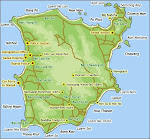
The history of Muay Thai - literally Thai Boxing - was lost when the Burmese army sacked and razed Ayuddhaya to the ground in 1767. The little we do know about Muay Thai's origin comes from the writings of the Burmese, Cambodian, early European visitors and some of the chronicles of the Lanna Kingdom - Chiangmai. What all sources agree on is that Muay Thai probably had its origins in China and began as a close combat battlefield skill, more deadly than the weapons it replaced. What is known is that Muay Thai was an essential part of Thai culture right from its dawn. It remains the national sport of Thailand and traditionally, the sport of Thailand's kings who've had great influence on its popularity and development over the centuries, being instrumental in moving it from the battlefield to the stadium ring.
Regardless of social position, many Thai people have practiced Muay Thai throughout their lives, if not as a combative skill, as a means of keeping supple and fit. It was part of the school curriculum until the 1920s and only withdrawn because it was thought that the injury rate was too high. Thais and countless foreigners the world over continued to practice Muay Thai in gyms, clubs and more recently - camps.
Muay Thai is now accepted as an official sport in Asian Games competition and, because of its increasing global popularity, there is pressure to have it included as an official Olympic sport.
In recent years Muay Thai has become extremely popular among many westerners, both men and women. Countless schools have sprouted-up throughout Thailand to meet the demand for those that desire authentic instruction and experience. Koh Samui has several of these Muay Thai 'camps' which provide enthusiasts the opportunity to combine a beach holiday with having the living daylights kicked out of them by skinny, long-limbed Thai kids.
Although recognizable as a form of boxing to westerners; bouts are fought in a square ring, with the protagonists having long ago replaced horse hair or rope bindings for familiar leather boxing gloves, any similarity ends there, as feet, knees, hands, elbows, and shoulders are all legal weapons. In addition to the fighting, there are numerous cultural aspects to a Muay Thai bout, including ritualistic dancing, ornamental head and armbands. And music, played somewhat tunelessly throughout each bout on a Pi Chawa, a kind of bagpipe, without the bag. In ancient times, Siamese people believed in the power of incantations and protective amulets, the common belief was that everything was ruled and inhabited by unseen spirits. And that places were either blessed or cursed. Because of these beliefs, it was necessary to perform special rites before a fighter entered the ring, asking the spirits' permission to do so.

Even today, before entering the ring many fighters perform rituals. It is very much a matter of individual preference these days, with no prescribed rules. Some may kneel before the ring, others might pray with their khru muay (lit. boxing teacher) or perform a series of repetitive movements, such as touching the ring ropes 3 times and avoiding the bottom stair before taking the first step up to the ring.
Fighters always leap over the ropes into the ring, because the head is considered to be more important than the feet and therefore it has to stay always above the feet while entering the ring. Contestants will then go to the center and pay respect (panom muae wai) in all four directions to the spectators.
Nothing is as exciting for an aficionado than the roar of the crowd and the traditional music, played when fighters perform their 'Wai Khru', a respectful homage dance to their teachers. Bouts are of 5, three minute rounds with a two minute break between each round. Winners are determined by either by a KO or by points if the fight lasts all 5 rounds. Points are given for knock downs, take downs, blows (knee blows to the kidneys during a clinch are highly rated) and the execution of kicks. Kicks are more valued than punches. Typically a fighter who kicks more than their opponent will pile up more points.

Muay Thai is big business for the island. Koh Samui's Chaweng Stadium is the biggest in Thailand dedicated to the sport and is a regular venue for fights by the sport's champions and biggest names, as well as local grown talent. Fight nights are normally held on Tuesday's and Friday's, with occasional specials at the weekend, from 21h00 until midnight and include ten bouts, starting with youngsters of 8 - 10 years old. The last fights being the most anticipated by the alway raucous crowd. Fight nights offer the spectacle, decent seating, cold beer and cost about 500 Baht. There are also fights at Lamai on Wednesday's and Saturday's.
Muay Thai isn't for everyone, but from the many Baan Bophut guests that have attended a Chaweng fight night, I've only had reports of what a great experience it was. And I don't think our guests are any more brutish than normal.


















No comments:
Post a Comment